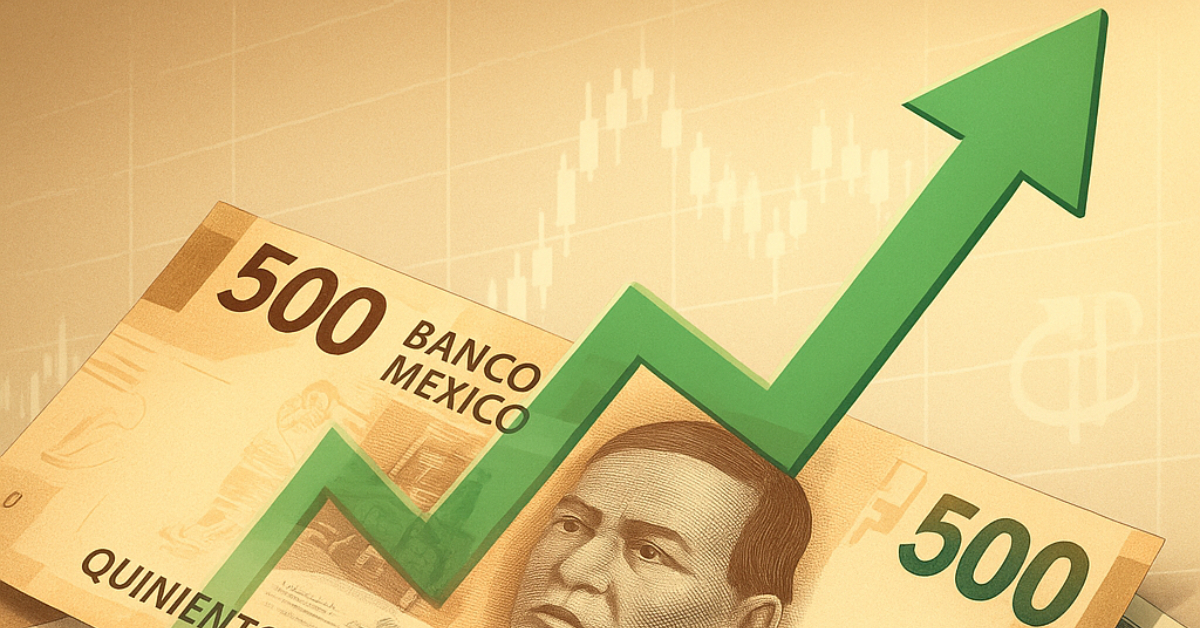The Mexican peso gained for a third consecutive day, closing at 18.9244 per dollar amid easing geopolitical tensions and anticipation of Banxico’s interest rate decision.
The Mexican peso appreciated for the third consecutive session on Wednesday, gaining ground against the U.S. dollar amid a calmer global market following the end of tensions between Israel and Iran. The easing of geopolitical risks appears to have restored some investor confidence, helping the peso make a modest but notable comeback.
According to official data from the Bank of Mexico (Banxico), the peso closed the day at 18.9244 per dollar, improving from Tuesday’s close of 18.9930. The gain of 6.86 cents, or 0.36%, marks the continuation of a short-term recovery after the currency recently dipped to 19.35 amid concerns over escalating conflict in the Middle East.
Over the last three sessions, the peso has accumulated a total gain of 24.39 cents, or 1.29%, since last Friday’s close of 19.1683 per dollar.
Dollar Weakens Amid Fed Signals
The broader weakness of the U.S. dollar also contributed to the peso’s momentum. The Intercontinental Exchange Dollar Index (DXY), which tracks the greenback’s performance against six major global currencies, fell 0.24% to 97.74 points. The dollar fluctuated between a high of 19.0300 pesos and a low of 18.8982 pesos throughout the trading day.
Investor sentiment was shaped in part by Federal Reserve Chairman Jerome Powell’s semiannual testimony before Congress, where he addressed ongoing inflationary risks. Powell warned that tariffs—particularly those proposed by former President Donald Trump—could maintain upward pressure on consumer prices, signaling that the Fed is in no rush to begin cutting interest rates.
“Today, the market is digesting Jerome Powell’s message, with no rush to cut interest rates and warning about the inflationary impact of tariffs,” said Jorge González, director at Asesores en Divisas y Riesgos. “Technically, it has a bearish bias.”
The Fed’s cautious tone has helped stabilize U.S. bond yields, but with no clear timeline for rate cuts, emerging market currencies like the peso are seeing renewed attention as investors reassess risk and yield differentials.
All Eyes on Banxico
Domestically, market participants are now turning their focus to Thursday’s Banxico monetary policy announcement, where a 50-basis-point rate cut is widely anticipated. If confirmed, it would mark the third consecutive cut of that size and would bring the benchmark interest rate down to 8%.
However, there is still some room for surprise. A more moderate move could signal a shift in the central bank’s approach to inflation and monetary tightening by the U.S. Federal Reserve.
“A 50-basis-point cut is expected, but a smaller cut could strengthen the peso given a smaller narrowing in the spread with the Fed’s policy,” said Juan Carlos Cruz, a Mexico-based financial consultant.
The narrowing interest rate differential between the U.S. and Mexico remains a key factor in exchange rate dynamics, and Thursday’s decision could either reinforce the peso’s current trajectory or stall the rally.
Market Outlook
Despite the peso’s recent appreciation, analysts remain cautious. Global uncertainties, ranging from tariff policies to central bank strategies, continue to pose risks. Should geopolitical tensions flare again or inflation indicators in the U.S. accelerate, the outlook for the peso could quickly change.
For now, the easing of international conflict and a measured pace of monetary policy discussion have allowed the peso to breathe. Thursday’s Banxico decision will likely set the tone for the local currency heading into the second half of the year.
The Mexican peso gained for a third consecutive day, closing at 18.9244 per dollar amid easing geopolitical tensions and anticipation of . . .











